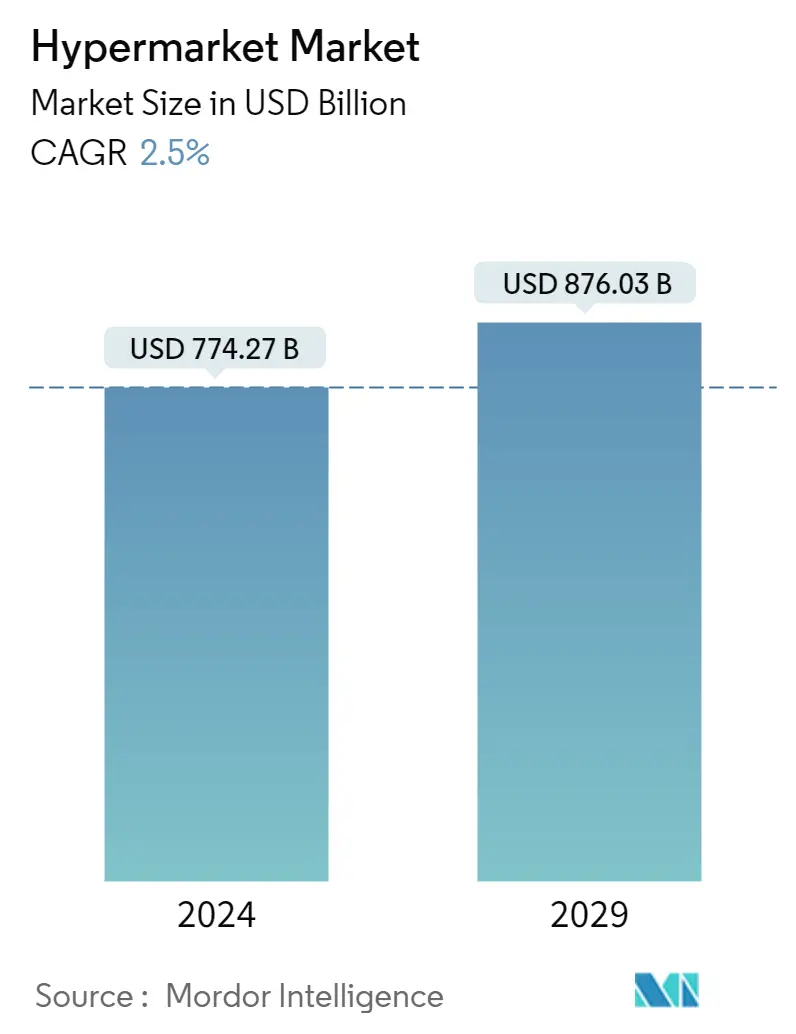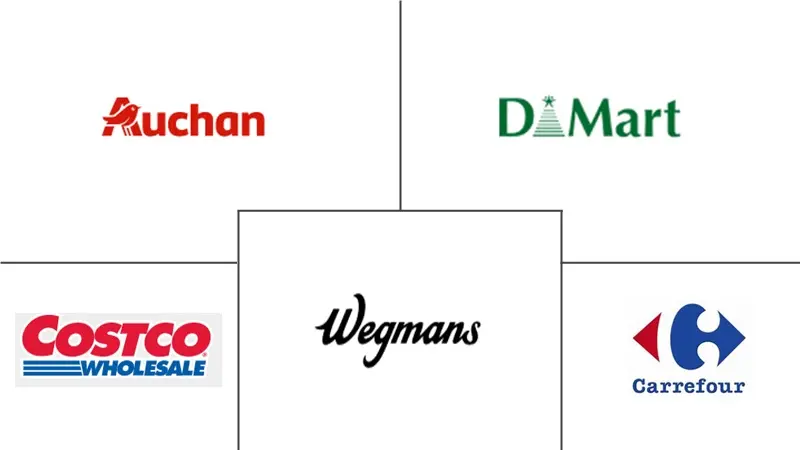Market Size of Hypermarket Industry

| Study Period | 2019 - 2029 |
| Market Size (2024) | USD 774.27 Billion |
| Market Size (2029) | USD 876.03 Billion |
| CAGR (2024 - 2029) | 2.50 % |
| Fastest Growing Market | Asia-Pacific |
| Largest Market | Europe |
| Market Concentration | Medium |
Major Players
*Disclaimer: Major Players sorted in no particular order |
Hypermarket Market Analysis
The Hypermarket Market size is estimated at USD 774.27 billion in 2024, and is expected to reach USD 876.03 billion by 2029, growing at a CAGR of 2.5% during the forecast period (2024-2029).
A hypermarket is a store that consists of supermarkets as well as department stores, with a wide range of products available under one roof. Hypermarkets can be found in urban as well as less-populated areas. Canada, Europe, Japan, the United States, and Australia were among the countries where the concept of hypermarkets was initially established and expanded globally. Hypermarkets in their global expansion are facing disruptions from e-commerce, which is leading to some developing countries omitting the hypermarket stage and jumping to e-commerce.
With the advent of COVID-19, as restrictions came into place and access to hypermarkets became difficult, the retail solution arrived with online ordering and delivery of products ranging from groceries to luxuries. This trend led to hypermarkets changing their business model by including online delivery services and opening new stores in Tier 2 and Tier 3 cities. Even on the consumer side, people moved away from small baskets from different stores to much bigger baskets purchased infrequently from one store. This created an opportunity for hypermarkets to expand their digital as well as offline services.
As the world has recovered from the pandemic, there was a surge in demand for non-food categories, which made available in hypermarkets with the space occupied by them included as a sunk cost for retailers. Through a huge shift to online, this is causing disruptions for hypermarket stores as products are available in variety as well as at a discount through online channels. This requires hypermarkets to review their business models as well as their sustainability.
Hypermarket Industry Segmentation
A hypermarket is a retail store combining a department store and a grocery supermarket. They offer a variety of products, ranging from appliances to groceries. The global hypermarket market is segmented by ownership (retail chain, independent retailer), by application (consumer electronics, furniture, food and beverage, toys and stationery, personal care, cosmetics, home textiles, dresses, other applications), and by region (Asia Pacific, Europe, North America, South America, the Middle East, and Africa). The report offers market size and forecasts for the global hypermarket market in volume (number of stores) and value (USD million) for all the above segments.
| By Ownership | |
| Retail Chain | |
| Independent Retailer |
| By Application | |
| Consumer Electronics | |
| Furniture | |
| Food and Beverage | |
| Toy and Stationary | |
| Personal Care | |
| Cosmetic | |
| Home Textile | |
| Dresses | |
| Other Applications |
| By Region | |
| Asia-Pacific | |
| Europe | |
| North America | |
| South America | |
| Middle East and Africa |
Hypermarket Market Size Summary
The hypermarket industry is experiencing a transformative phase, driven by the integration of online retail channels and the expansion of physical stores in emerging markets. Initially established in regions like Canada, Europe, Japan, the United States, and Australia, hypermarkets have faced challenges from the rapid growth of e-commerce, particularly in Asia and North America. The COVID-19 pandemic accelerated the shift towards online shopping, prompting hypermarkets to adapt by enhancing their digital services and expanding into Tier 2 and Tier 3 cities. This shift has allowed hypermarkets to capitalize on the increased demand for non-food categories, although it has also necessitated a reevaluation of their business models to remain competitive against the growing prevalence of online shopping.
As the global economy recovers, hypermarkets are poised for growth, leveraging their low-cost, all-under-one-roof shopping experience to attract consumers. Major players like Walmart, Target, and Kaufland are expanding their global presence through acquisitions and partnerships, aiming to capture a larger market share. The rise of digital marketing has also enabled smaller businesses to enhance their market presence, further intensifying competition. Despite the challenges posed by e-commerce, hypermarkets continue to play a significant role in the retail landscape, with ongoing expansions and strategic acquisitions supporting their growth trajectory.
Hypermarket Market Size - Table of Contents
-
1. MARKET DYNAMICS AND INSIGHTS
-
1.1 Market Overview
-
1.2 Market Drivers
-
1.3 Market Restraints
-
1.4 Industry Value Chain Analysis
-
1.5 Industry Attractiveness - Porter's Five Forces Analysis
-
1.5.1 Bargaining Power of Buyers
-
1.5.2 Bargaining Power of Suppliers
-
1.5.3 Threat of New Entrants
-
1.5.4 Threat of Substitutes
-
1.5.5 Intensity of Competitive Rivalry
-
-
1.6 Insights of Technology Innovations in the Market
-
1.7 Impact of COVID-19 on the Market
-
-
2. MARKET SEGMENTATION
-
2.1 By Ownership
-
2.1.1 Retail Chain
-
2.1.2 Independent Retailer
-
-
2.2 By Application
-
2.2.1 Consumer Electronics
-
2.2.2 Furniture
-
2.2.3 Food and Beverage
-
2.2.4 Toy and Stationary
-
2.2.5 Personal Care
-
2.2.6 Cosmetic
-
2.2.7 Home Textile
-
2.2.8 Dresses
-
2.2.9 Other Applications
-
-
2.3 By Region
-
2.3.1 Asia-Pacific
-
2.3.2 Europe
-
2.3.3 North America
-
2.3.4 South America
-
2.3.5 Middle East and Africa
-
-
Hypermarket Market Size FAQs
How big is the Hypermarket Market?
The Hypermarket Market size is expected to reach USD 774.27 billion in 2024 and grow at a CAGR of 2.5% to reach USD 876.03 billion by 2029.
What is the current Hypermarket Market size?
In 2024, the Hypermarket Market size is expected to reach USD 774.27 billion.

